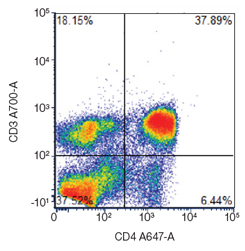Rat Flow Cytometry Products and Resources

- On This Page
- Resources
- Rat Flow Cytometry Antibodies
To assist your experiments, you can find on this page a helpful resource on cell frequencies in common rat samples and our range of rat-specific antibodies.

Staining rat lymphocytes. Viable cells were identified by PI (1351101) staining. Rat peripheral blood was stained with CD3 A700 (MCA772A700) and CD4 A647 (MCA55A647) and gated on lymphocytes to identify T cells. Data was acquired on the ZE5 Cell Analyzer.
Resources
Cell Frequencies in Common Samples
Cell frequency can influence the choice of fluorophore and how many cells you will need to collect to obtain statistically significant data, crucial with rare populations.
We have produced a handy table showing the relative frequency of cells in commonly used rat tissues, allowing you to plan and predict your flow populations.
Rat Cell Frequency
| Spleen | Thymus | Peripheral Blood | |||
|---|---|---|---|---|---|
|
Cell Type |
Percent |
Cell Type |
Percent |
Cell Type |
Percent |
|
T cells |
31.5-33.5 |
CD4+ |
5.7-9.4 |
T cells |
51.5-66.5 |
|
CD4+ |
21.5-26.5 |
CD8+ |
2.3-6.9 |
CD4+ |
32-40 |
|
CD8+ |
14-18 |
CD4+/8+ |
83-87.6 |
CD8+ |
18-26 |
|
B cells |
51-59 |
CD4-/8- |
1.4-2.2 |
B cells |
22.7-40.7 |
|
|
|
|
|
Monocytes |
1-6 |
|
|
|
|
|
Neutrophils |
14-20 |
|
|
|
|
|
Eosinophils |
1-4 |
|
|
|
|
|
Basophils |
Rare |
|
|
|
|
|
γδ T cells |
1-2 |
|
|
|
|
|
NK cells |
6-10 |
These values are for reference only and there may be variation due to sample preparation, individual variation, and the strain of animal used.
All values shown are percentages of total leukocytes in each sample.
For more information about the importance of cell frequency in your flow cytometry experiment, please read our full guide.
Rat Flow Cytometry Antibodies
| Description | Target | Format | Clone | Applications | Citations | Code |
|---|




